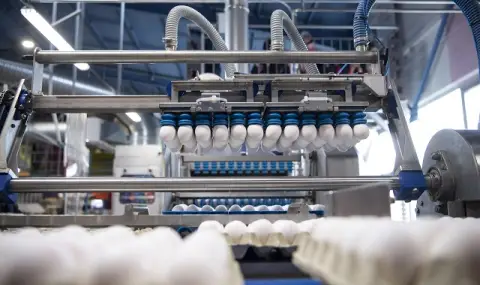Large parts of the world welcome Easter, and two products invariably associated with the spring holiday - chocolate and eggs - are at record price levels.
About three-quarters of the world's cocoa - the main ingredient in chocolate - is produced from cocoa trees in Ghana, Côte d'Ivoire, Nigeria and Cameroon. Cocoa trees only grow near the equator and are particularly sensitive to changes in weather. In recent months, these countries have been buffeted by strong seasonal dusty winds from the Sahara that have blocked the sunlight needed for bean pods to grow, the Associated Press reported. In the previous season, heavy rains contributed to the spread of a disease that causes rot, and many farmers blame climate change for the poor harvest.
Cocoa is traded on a regulated global market. Farmers in producing countries sell to local traders or processors, from whom global chocolate companies then buy cocoa products, and prices are set up to a year in advance.
After exports from Ivory Coast, the world's biggest producer, fell by a third in recent months, the world price of cocoa has risen sharply. Cocoa futures have doubled since the start of the year, trading at a record high of more than $10,000 a metric ton in New York on Tuesday, after already jumping more than 60 percent last year. However, farmers say this price growth is still not enough to cover their lower yields and higher production costs.
The high demand for chocolate at Easter, however, brings potential profits for the big confectionery companies. Major global producers in Europe and the United States have passed on the increase in cocoa prices to consumers. The net profit margin at "Hershey" (Hershey Company) increased to 16.7 percent in 2023 from 15.8 percent in 2022. "Mondelez International" (Mondelez International), owner of the brands "Toblerone" (Toblerone) and "Cadbury" (Cadbury), reported a jump to 13.8 percent in 2023 from 8.6 percent the previous year. The company said it raised chocolate prices by up to 15 percent last year and will consider further increases to meet its 2024 revenue growth forecasts.
In the UK, the British marketing company "Which?" (Which?) found that this year, chocolate Easter eggs and bunnies from popular brands such as "Lind" (Lindt) and "Toblerone" are about 50 percent more expensive. Some of the sweet eggs are also smaller.
In Switzerland, which consumes the most chocolate per capita in the world, domestic consumption fell slightly last year, falling 1 percent to 10.9 kg per person, according to trade association "Chocosuis" (Chocosuisse), which explains this decline with the increase in the price of retail chocolate.
Inflation is easing globally, but is still higher than economists had hoped for this period in 2024. Analysts are increasingly concerned about the impact of persistently high inflation and high interest rates on consumer spending and the overall economic growth.
As part of the trend near historic records, egg prices are also under pressure due to the spread of bird flu, high demand and rising costs for farmers.
Although global prices are lower than at the same time last year, they remain at a high level, notes Nan-Dirk Mulder, senior global expert at the division of the Dutch financial group "Rabobank" (Rabobank) - "RaboResearch food and agribusiness" (RaboResearch Food and Agribusiness). He does not expect a return to the levels of 2021.
A dozen eggs in the US averaged $2.99 in February, down from $4.21 last year, government data show. However, this is significantly more than $1.59, the price consumers were paying in February 2021.
In Europe, eggs are 10 to 15 percent cheaper compared to last year, but nearly twice as expensive compared to 2021, reports Mulder.
Among the main factors behind this trend is bird flu. Outbreaks of the deadly bird disease were reported in Europe, Africa and Asia in 2020, and in 2021 it spread to North America. In 2022 alone, worldwide, more than 131 million birds died from the pathogen or were destroyed to prevent its spread, according to the World Health Organization (WHO). The disease continues to spread. In December, cases were confirmed in the US at 45 commercial farms and 33 home farms, affecting 11.4 million birds, the US Department of Agriculture informed.
In South Africa, eggs soared after 40 percent of laying hens died last year due to bird flu. A pack of six eggs cost 25.48 South African rand ($1.34) last month, or 21 percent more than in February 2023.
Even after bird flu subsides, it may take a long time for the egg market to calm down. It takes three to six months for a farm to rebuild a lost flock, so that's when egg supplies are tighter and prices rise, explains Emily Metz, president of the American Egg Council, a trade organization. However, if the farm fills its flock with too many birds, prices can drop.
At the same time, during periods of inflation, it is difficult for farmers to make a profit. Chicken feed accounted for up to 70 percent of farm costs, and feed doubled in price between 2020 and 2022, Mulder said. Factors such as supply chain disruptions related to COVID-19 and the war in Ukraine have contributed to this.
In Nigeria, a cent per pack of eggs has doubled since the beginning of the year due to the weakening of the national currency, the removal of fuel subsidies and high costs for farmers.
In Bulgaria, eggs are sold for 36 cents a piece - below last year's levels, stated earlier this week in an interview with BTA, the chairman of the State Commission on Commodity Exchanges and Markets (DKSBT) Vladimir Ivanov.
Towards the end of March last year - three weeks before Easter - wholesale eggs in our country were sold at 41 cents, and according to Eurostat data, in January 2023 they rose in price by more than 70 percent on an annual basis.
